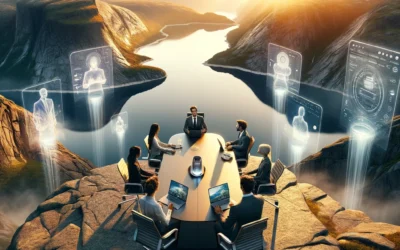CEOs face significant challenges this year, with a turbulent macro environment and virtually every industry holding rich opportunities for disruptive innovation. Based on our research and interaction with Global 2000 leaders and investors, we believe the following themes deserve special attention from everyone in 2024.
1. Putting Generative AI to Work
In 2024, more enterprises will shift from evaluating and experimenting with Generative AI solutions to implementing them. As they gain experience, we will likely see significant productivity improvements across various functions, including R&D, customer support, sales, procurement, accounting, strategy, and governance. Software developers are using AI copilots to improve their productivity, which means that applications that enhance productivity in a wide range of domains will evolve faster.
Many practical difficulties and uncertainties exist around technology stacks. Platforms are evolving very quickly, with several significant players competing. Understanding which components will interface with humans and how to connect the various components remains in flux.
For successful implementation, enterprises must focus on real problems worth solving and not just use them as demo opportunities for AI. They must also find practical solutions to various LLM issues, such as hallucinations, lack of grounding, math errors, accuracy, privacy, and intellectual property rights controversies. The solution is not to wait –enterprises must accelerate their efforts to gain experience.
2. Speeding Enterprise Transformation
The Price Waterhouse Coopers 2023 Global CEO Survey [1] revealed that 40% of CEOs are not confident that their companies will remain economically viable in the next ten years. Technology alone will not be enough –– enterprises must go beyond operating efficiency and pursue new products and business models.
Organizations must move toward dynamic networks of humans and AIs to speed their evolution. Decentralization of work is no longer a debate; it has already happened. The COVID-19 pandemic brought significant changes to the world of work. According to a recent Gartner study [2], there are 100 million knowledge workers in the United States, and 71% of them still work remotely at least part of the time.
All knowledge workers will be using AIs, even if no overarching enterprise initiative exists to make this happen. It is already happening ––from the bottom up. According to OpenAI, 80% of Fortune 500 companies already have employees using ChatGPT for work[3].
Redesigning work as a top-down initiative is less feasible than it used to be. A decentralized workforce expects more autonomy than in the past, and centralized initiatives tend to roll out slowly. Leaders must find ways to empower people from the bottom up and motivate them to pursue projects that are meaningful for them. At the same time, they must provide a platform that facilitates learning and collaboration. The Future of Work is in AI-enabled Work Platforms that make it easy to design and redesign how and who we work with on the fly.
Adopting AI in corporate innovation and product development will accelerate the evolution of all industries. Incumbents must seek to develop barriers to entry that cannot easily be overcome by competitors who are also using AI.
3. Improving the Customer Experience (and More)
As AI is leveraged to improve the Customer Experience, customers will begin to have higher expectations. Companies with rich product offerings are already attempting to leapfrog competitors by leveraging Generative AI to build Copilots that work across multiple products. SAP’s Joule and Microsoft’s Office Copilots are good examples of this.
The more complex the product portfolio, the greater the challenge of improving Customer Experience. Talking with separate AIs for different products without shared context will cause user friction and loss of trust. Copilots must be trained on the products as they evolve, and their development must be integrated into the product development process.
When a product contains its own customer service capability, we may no longer need a separate organizational silo for customer support. It might make more sense to organize horizontally for continuous service delivery.
A company’s brand has a distinct personality, and it is vital to ensure that the behavior of the AI matches that personality. More broadly, enterprises must leverage what they learn also to benefit the Employee Experience, Buying Experience, and Vendor Experience. AIs will become the “interface” for the organization.
4. AI is coming to Cybersecurity
Cybersecurity is already an arms race, and Generative AI is taking it to the next level. Social engineering attacks will be automated, making them much more scalable. We have already seen Generative AI used to create fake images, videos, and voice samples, bypassing user identification steps. It can also be used to create phishing emails that look very real and convincing. Bad actors can also use Generative AI to compose on-the-fly penetration code.
Thankfully, enterprises can leverage Generative AI to defend themselves. Developers can use copilots to find security vulnerabilities in new and legacy source code. AIs can also generate synthetic data to simulate new attack patterns and recognize phishing emails. By proactively adopting Generative AI in cyber security, enterprises can avoid financial losses and protect brand value.
5. Navigating a Turbulent Environment
The US National Debt has now passed 34 trillion dollars and continues to hamper economic growth. We expect inflation to remain an ongoing problem in 2024 and beyond, with growth slowing worldwide.
As much as we have argued for less government intervention in industry, 2024 will bring more of it. Regulatory overhead and uncertainty will continue to be a drag on innovation in a wide range of industries. Silicon Valley venture firm Andreessen Horowitz announced in December 2023 that they would financially support candidates with pro-growth and pro-innovation policy agendas [4]. We think advocating for economic freedom is a positive step.
The geopolitical situation is even more strained than a year ago, with the October 7, 2023 atrocities by Hamas and the ensuing efforts of Israel to rid Gaza of a terrorist regime hiding behind its civilian population. These efforts will likely continue throughout 2024, with civilian casualties unavoidably mounting. As the Hamas leadership had hoped, the conflict has put a hold on the effort to improve the relationship between Israel and Arab countries. It has also impacted the safety of shipping lanes.
Russia’s bloody war on Ukraine continues, with the latter’s 2023 counteroffensive having enjoyed only limited success. The US Federal Government appears paralyzed in dealing with a challenging Southern border situation, and further funding for Ukraine is tied to finding an agreement concerning illegal immigration. Meanwhile, China and Russia are moving toward a military alliance, which would pose a considerable security challenge for the US and its allies.
According to US Government figures, 60% of the world’s energy production comes from fossil fuels, 21% from nuclear plants, and 18% from renewables [5]. Our reliance on fossil fuel-based energy sources will continue for the foreseeable future despite ambitions to the contrary. Regardless of the energy source, the cost and reliability of energy remain essential success factors in many industry sectors.
America is as politically divided as ever as the November election looms, the outcome of which will have a significant policy impact for the following year.
For enterprise leaders, these macro challenges have both an external and an internal impact. Conflicts will affect demand, currency values, supply chains, and market access. Internally, any public statements made by leaders will often ignite differences of opinion among employees, so leaders must choose their battles and speak with clarity and conviction.
6. Fighting the Talent War
Meeting the challenges described herein is impossible without the right people. Many enterprises are facing a labor shortage. According to the US Bureau of Labor Statistics, 37.5% of the working-age population in the US is not working or not actively looking for work[6]. The labor force participation of 62.5% is the lowest the country has seen in fifty years. Sectors struggling to fill roles include Transportation, Hospitality, Manufacturing, Health care, and Retail. For every person looking for work, there are 1.7 job positions open. This situation provides a huge incentive to improve productivity through automation.
At the same time, the nature of the jobs available is changing. According to an edX survey released in September 2023, C-suite executives believe that 49% of the skills in their workforce will not be relevant in 2025, and 47% of their employees are unprepared for the future of work [7].
Hiring and retaining the talent needed for innovation and transformation is also challenging. Generative AI will improve knowledge worker productivity, but people with more AI backgrounds are still required. 77% of the executives surveyed by edX believed AI was disrupting their business strategy, and 87% reported struggling with recruiting AI talent.
Gartner reported similar challenges in a 2023 survey of Chief Information Officers. 86% of Chief Information Officers reported facing more competition for qualified candidates, and 73% were worried about IT talent attrition.
7. Post-Industrial Summit 2024: The AI Transformation
We will be discussing solutions to the challenges raised here in upcoming articles. You may also want to register for our February 28-29 Summit, where delegates can interact with invited experts and learn from them directly.
References
- Price Waterhouse Coopers. 2023. “Global CEO Survey.” Retrieved January 7, 2024 (https://www.pwc.com/gx/en/ceo-agenda/ceosurvey.html).
- Gartner. 2023. “Gartner Forecasts 39% of Global Knowledge Workers Will Work Hybrid by the End of 2023.” Retrieved January 7, 2024 (https://www.gartner.com/en/newsroom/press-releases/2023-03-01-gartner-forecasts-39-percent-of-global-knowledge-workers-will-work-hybrid-by-the-end-of-2023).
- OpenAI. 2024. “Introducing ChatGPT Enterprise.” Retrieved January 8, 2024 (https://openai.com/blog/introducing-chatgpt-enterprise).
- Horowitz, Ben. “Politics and the Future.” Andreessen Horowitz. Retrieved January 7, 2024 (https://a16z.com/politics-and-the-future).
- US Energy Information Administration. 2024. “Frequently Asked Questions.” Retrieved January 7, 2024 (https://www.eia.gov/tools/faqs/faq.php?id=427).
- US Bureau of Labor Statistics. 2024. “Employment Situation Survey.” Retrieved January 8, 2024 (https://www.bls.gov/news.release/empsit.nr0.htm).
- edX. 2023. “The 2023 edX AI Survey.” Retrieved January 8, 2024 (https://campus.edx.org/hubfs/B2B%20PDFs/edX_Workplace_Intelligence_AI_Report.pdf)
- Gartner. 2023. “Do Recent Layoffs Mean the Tech Talent Crunch is Over?” Retrieved January 8, 2024 (https://www.gartner.com/en/newsroom/press-releases/2023-03-07-do-recent-layoffs-mean-the-tech-talent-crunch-is-over).










